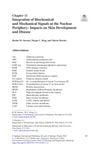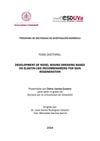Search
forLearn
4 / 4 resultslearn Osteopontin
signaling protein that, when suppressed, may grow hair by reducing inflammation and stem cell loss
learn Thymosin Beta 4
learn Low Level Laser Therapy
laser therapy for anti-inflammatory and likely insignificant hair regrowth effects
Research
5 / 1000+ resultsresearch Molecular Genetics of Inherited Disorders of Epidermal Keratins
Mutations in keratin genes cause skin disorders, but new treatments show promise.

research Integration of Biochemical and Mechanical Signals at the Nuclear Periphery: Impacts on Skin Development and Disease
The conclusion is that the nuclear lamina and LINC complex in skin cells respond to mechanical signals, affecting gene expression and cell differentiation, which is important for skin health and can impact skin diseases.
research Stem Cell Therapies for Epidermolysis Bullosa Treatment
Stem cell therapies may help improve symptoms and quality of life for people with epidermolysis bullosa.

research Development of Novel Wound Dressing Based on Elastin-Like Recombinamers for Skin Regeneration
Elastin-like recombinamers show promise for better wound healing and skin regeneration.

research Integrating Proteomics Revealed Key Targets for Molecular Breeding of Fine Cashmere Traits in Cashmere Goats
Key proteins affecting cashmere fiber quality were identified for better breeding.
Community Join
5 / 81 resultscommunity Clearing the air on how non-surgical treatments really work
Treatments for hair loss, including finasteride, dutasteride, minoxidil, ketoconazole, microneedling, and low level laser light therapy, which aim to reduce DHT production, increase cell absorption and blood flow, and stimulate epidermal stem cells. It also stresses the importance of patience when using these treatments.
community The end of balding: We may have just found the secret to hair regrowth
MCL-1 is important for hair follicle stem cell survival, but its impact on human hair regrowth is unclear. Minoxidil and finasteride are the main treatments, with doubts about new discoveries leading to effective human solutions soon.
community PP405: The Ultimate Hair Loss Drug for Complete Hair Growth
PP405 is a new hair loss treatment in phase 2 trials that may promote hair growth by increasing lactate production and activating hair follicle stem cells. It could potentially replace hormone-disrupting treatments like Minoxidil and finasteride.
community New and Interesting HairLoss Studies/Papers/Reviews
Hair loss treatments discussed include Dutasteride with Ketoconazole, tissue engineering strategies, and androgenetic alopecia therapies. Massage doubles follicular retention, improving treatment effectiveness.

community Minoxidil Response Bottlenecks: Why Sulfation and Transport Matter (And Where Tretinoin Fits In)
Minoxidil's effectiveness is limited by the need for sulfation and proper transport to hair follicles, with tretinoin potentially enhancing its effects by promoting enzyme activity and keratinocyte differentiation. Tretinoin may improve minoxidil's response by boosting the expression of necessary enzymes and transporters.